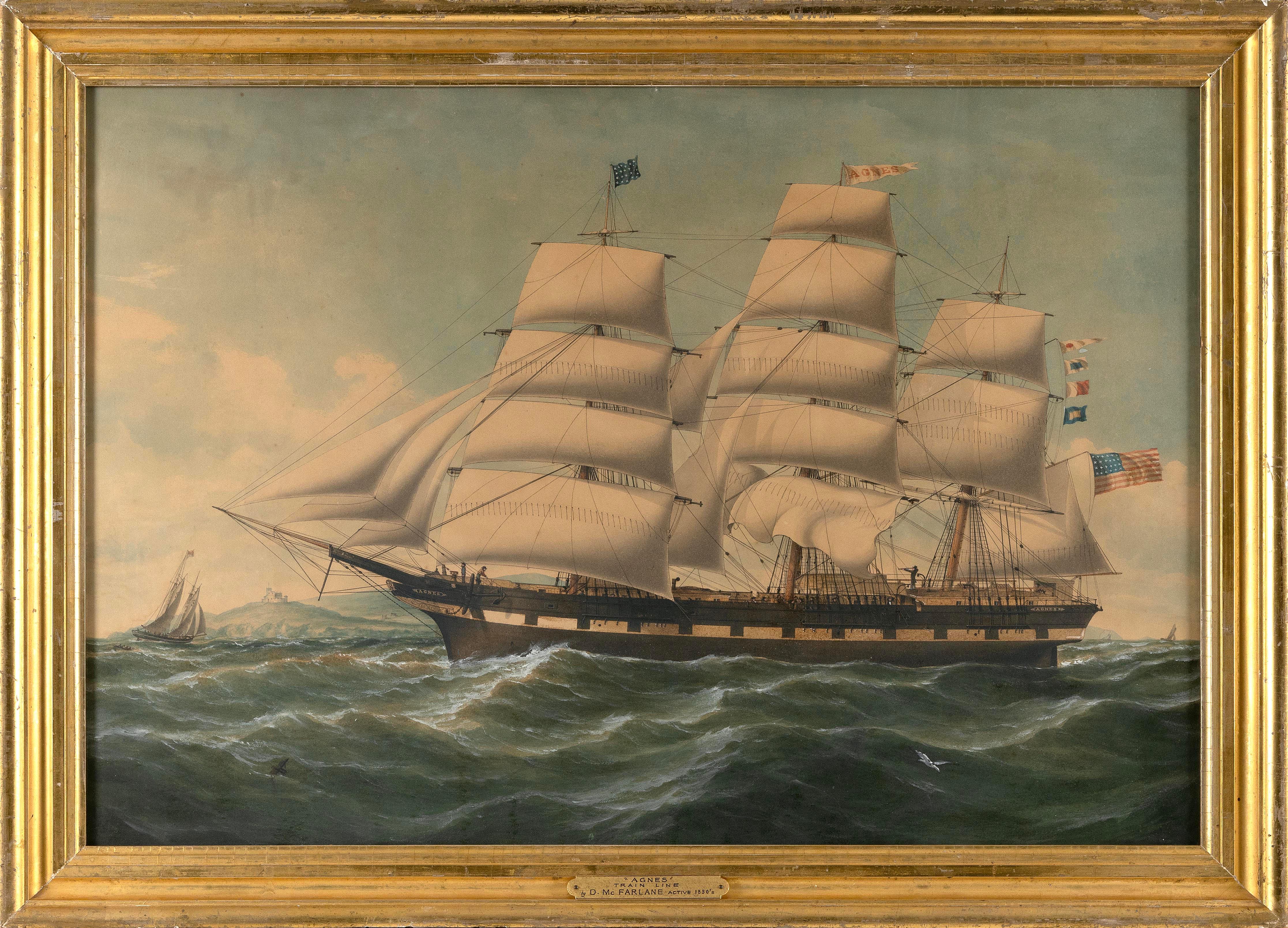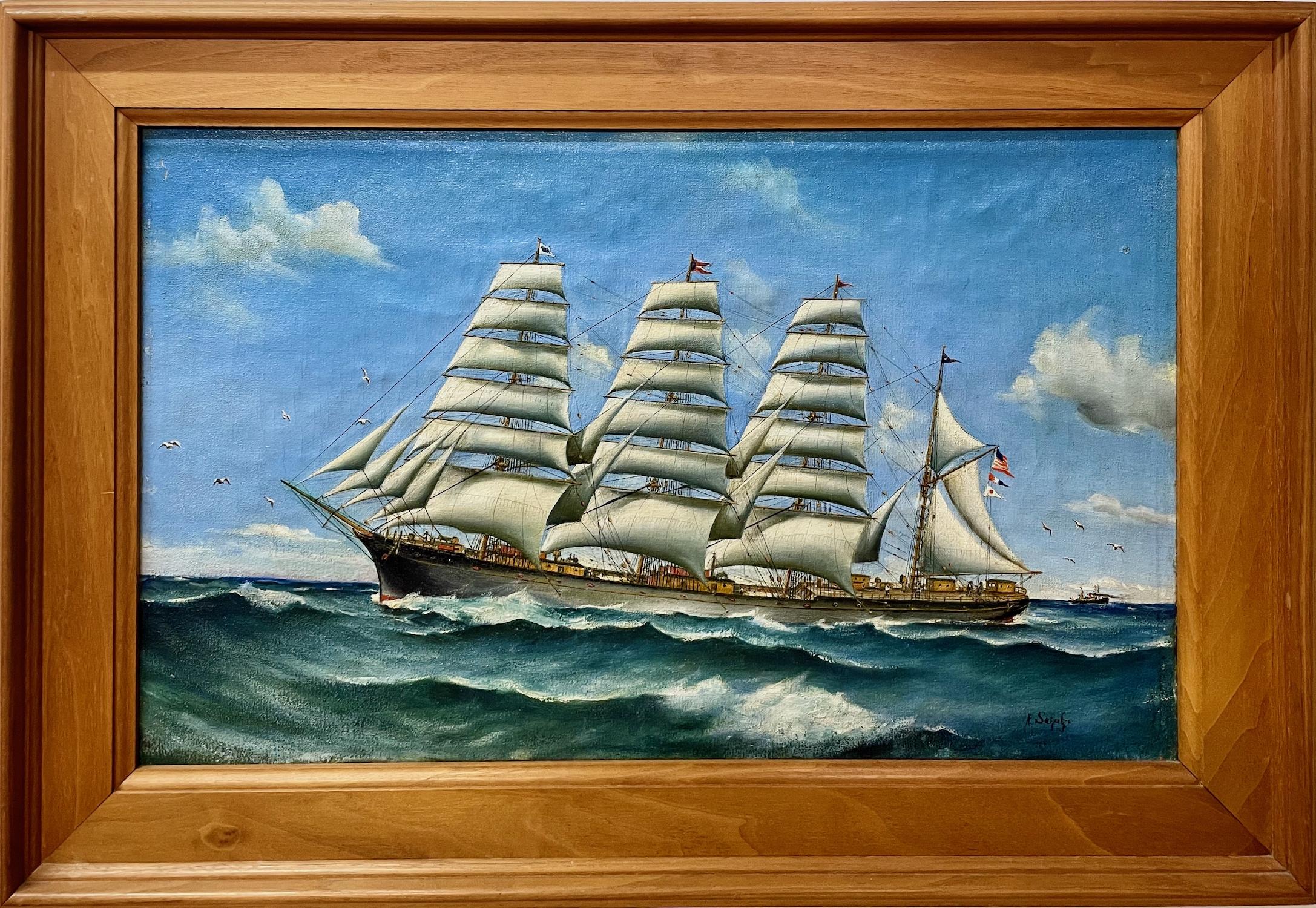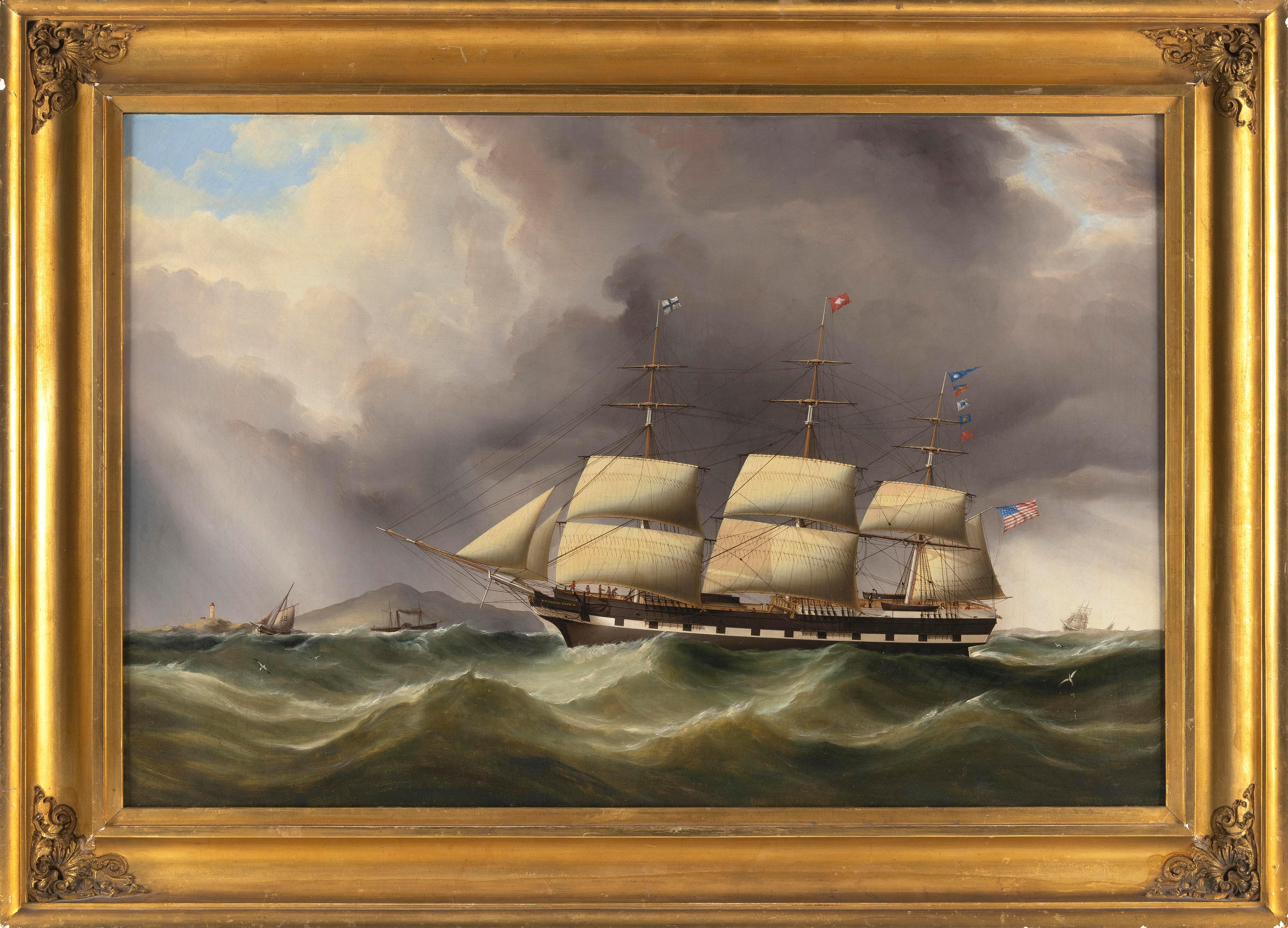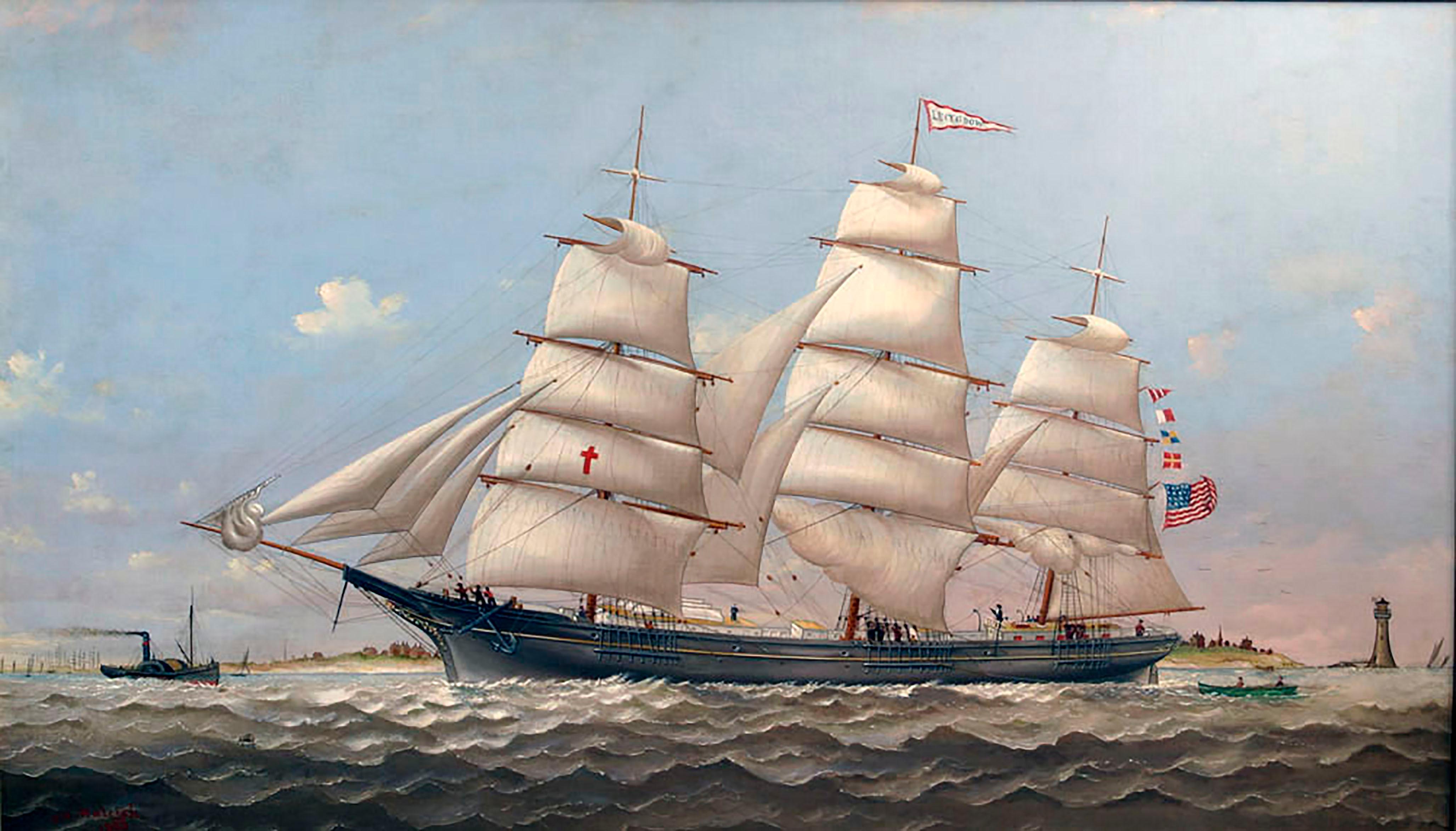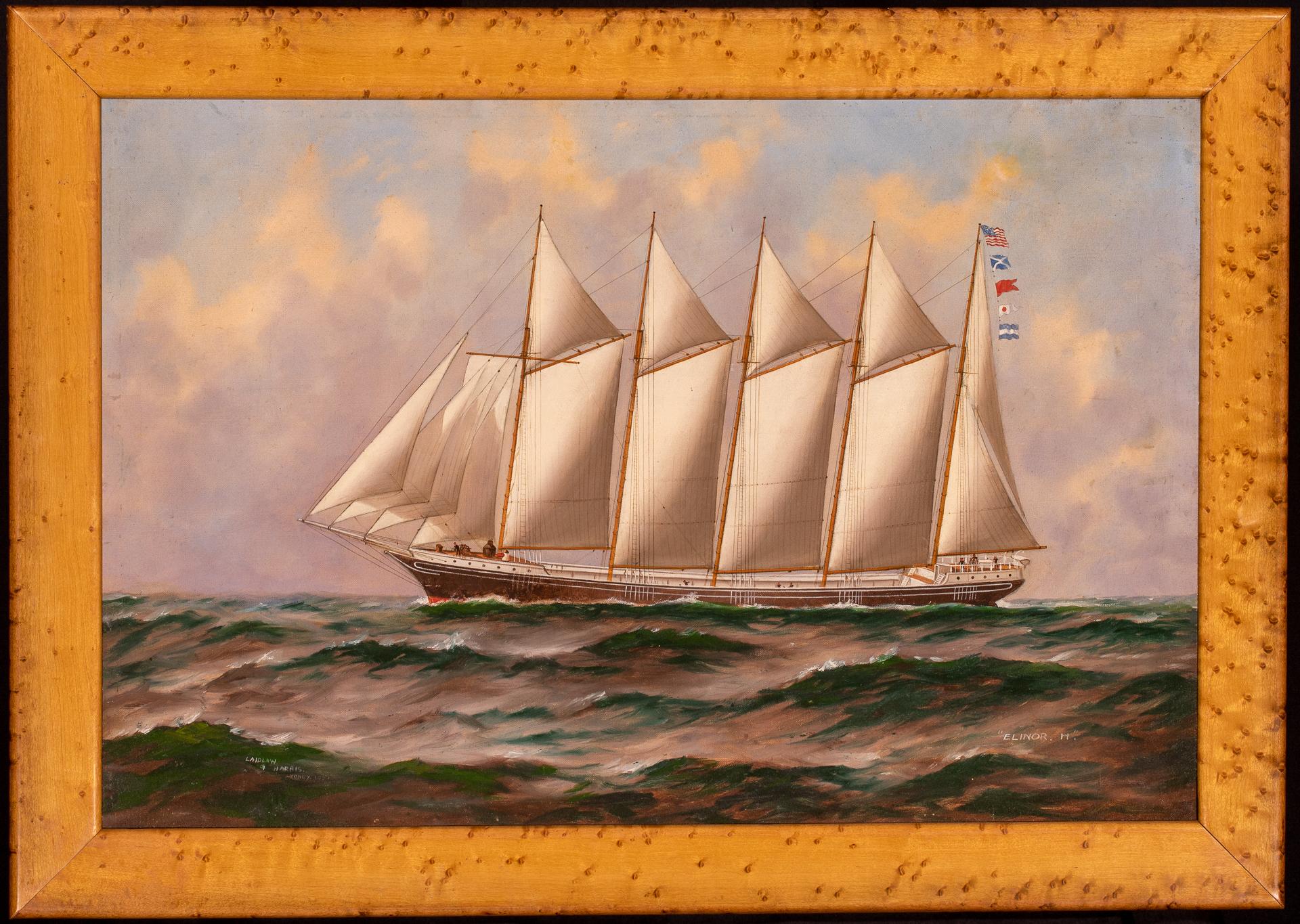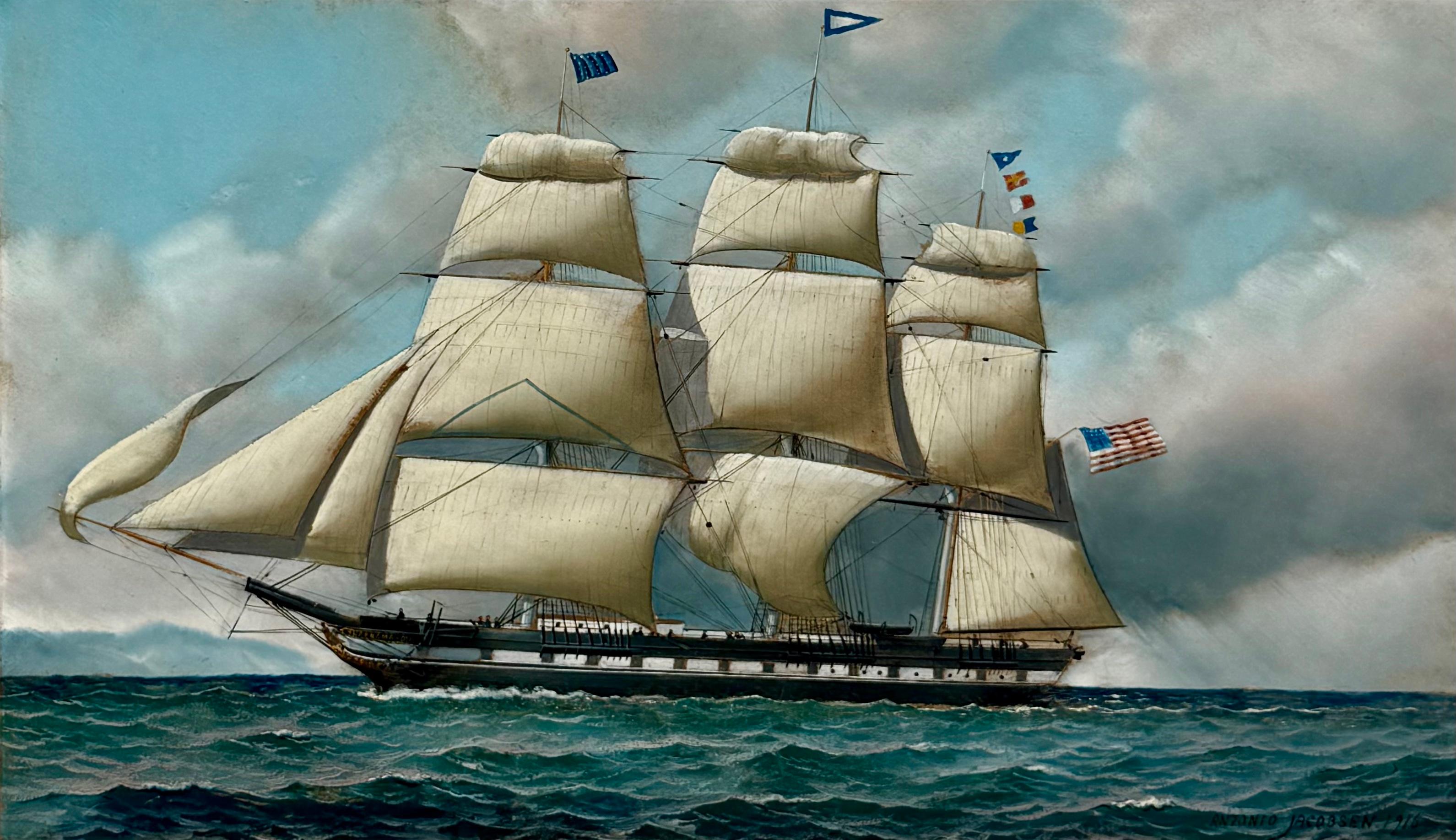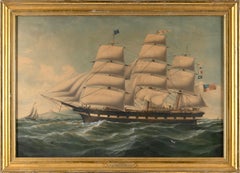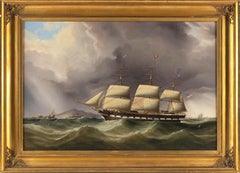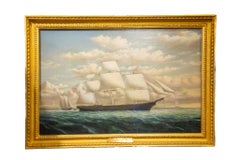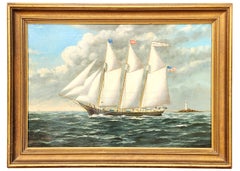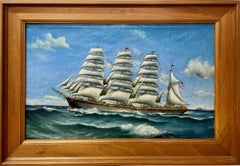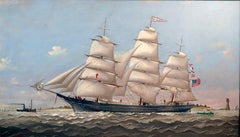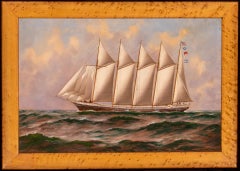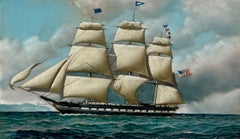Items Similar to "The Clipper Ship Reporter"
Video Loading
Want more images or videos?
Request additional images or videos from the seller
1 of 16
"The Clipper Ship Reporter"circa 1850
circa 1850
$32,000
£24,169.72
€27,933.25
CA$44,884.90
A$49,923.53
CHF 26,128.91
MX$608,902.46
NOK 328,319.23
SEK 308,826.62
DKK 208,494.53
About the Item
Attributed to Hin Qua (Chinese, 19th Century)
Signed in pencil to the verso
Marine Arts Company attribution label to verso
Stamp referring to restoration treatment by Gustav D. Klimann, dated 1971 to verso
A magnificent testament to the golden age of maritime trade, The Clipper Ship Reporter by Hin Qua captures the elegance and power of one of the fastest merchant vessels of its time. The painting presents the ship in full sail, gliding through a serene yet dynamic seascape, its billowing sails taut with the ocean breeze. The artist’s meticulous attention to detail is evident in the fine rendering of the ship’s rigging, the shimmering reflections on the water, and the subtle interplay of light and shadow across the sky. With a palette of rich blues, crisp whites, and warm ochres, the scene conveys both movement and grandeur, evoking a sense of adventure and the boundless possibilities of the open sea.
Hin Qua, an accomplished 19th-century Chinese maritime painter, is renowned for his exquisite ship portraits, particularly those commissioned by Western traders during the height of the China Trade era. Based in the bustling port of Canton (now Guangzhou), he specialized in detailed and highly accurate depictions of Western vessels that frequented Chinese waters. His works are distinguished by a blend of Western precision in perspective and proportion with a distinctively Chinese sensitivity to color, atmosphere, and composition. Through his paintings, Hin Qua documented an era of global commerce, offering a rare artistic perspective on the grandeur of the clipper ships that connected East and West.
As a key figure in the China Trade painting tradition, Hin Qua’s work holds significant historical and artistic value. His paintings not only celebrate the craftsmanship and majesty of 19th-century maritime engineering but also serve as a bridge between Eastern and Western artistic sensibilities. The China Trade artists played a crucial role in preserving a visual record of the international shipping industry at its peak, capturing the vessels that shaped global commerce. The Clipper Ship Reporter stands as an exquisite example of this genre, making it a prized acquisition for collectors of maritime art and historical ship portraits alike.
Provenance:
Marine Arts Company, Salem, Massachusetts.
Maritime painting
27456-LU2595214032132
- Attributed to:Hin Qua
- Creation Year:circa 1850
- Dimensions:Height: 23 in (58.42 cm)Width: 32.25 in (81.92 cm)
- More Editions & Sizes:Framed 29" x 38"Price: $32,000
- Medium:
- Period:
- Condition:This piece and the accompanying frame are in Good Condition and deserve to be in the collection of an owner who truly appreciates them. We welcome all inquiries regarding design, construction, and condition.
- Gallery Location:Jacksonville, FL
- Reference Number:Seller: 274561stDibs: LU2595213678652
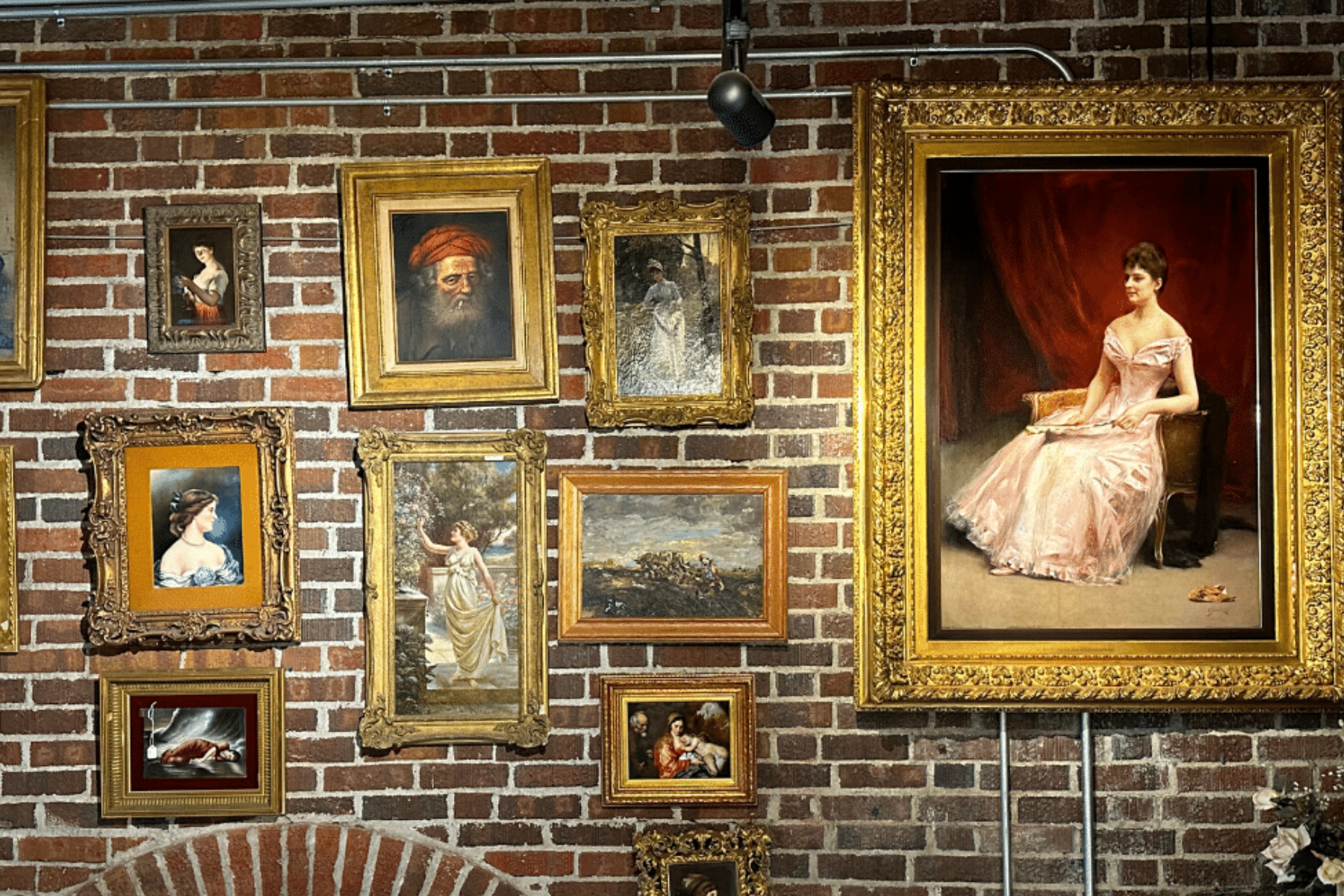
About the Seller
No Reviews Yet
Vetted Professional Seller
Every seller passes strict standards for authenticity and reliability
Established in 1960
1stDibs seller since 2023
17 sales on 1stDibs
Typical response time: 1 hour
- ShippingRetrieving quote...Shipping from: Jacksonville, FL
- Return Policy
Authenticity Guarantee
In the unlikely event there’s an issue with an item’s authenticity, contact us within 1 year for a full refund. DetailsMoney-Back Guarantee
If your item is not as described, is damaged in transit, or does not arrive, contact us within 7 days for a full refund. Details24-Hour Cancellation
You have a 24-hour grace period in which to reconsider your purchase, with no questions asked.Vetted Professional Sellers
Our world-class sellers must adhere to strict standards for service and quality, maintaining the integrity of our listings.Price-Match Guarantee
If you find that a seller listed the same item for a lower price elsewhere, we’ll match it.Trusted Global Delivery
Our best-in-class carrier network provides specialized shipping options worldwide, including custom delivery.More From This Seller
View AllPortrait Of The Ship Agnes
Located in Jacksonville, FL
Duncan McFarlane. This excellent ship portraitist began his life's work in Liverpool. It is believed that he later sailed to America and was employe...
Category
Mid-19th Century Landscape Paintings
Materials
Watercolor, Gouache
Portrait Of The Ship Plymouth Rock
Located in Jacksonville, FL
Duncan McFarlane. This excellent ship portraitist began his life's work in Liverpool. It is believed that he later sailed to America and was employe...
Category
19th Century Landscape Paintings
Materials
Canvas, Oil
CLIPPER SHIP - NORTHERN LIGHT OF BOSTON
By Fitz Henry Lane
Located in Jacksonville, FL
Fitz Henry Lane....Americas Earliest Marine Master Painter
The clipper ship "Northern Light" was painted about 1850-51. It was hung in the India House...
Category
19th Century Paintings
Materials
Oil
The Three Masted Schooner Samuel H. Hawes
Located in Jacksonville, FL
William Pierce Stubbs’ The Three-Masted Schooner Samuel H. Hawes is a striking maritime portrait that captures the majesty and strength of this g...
Category
Late 19th Century Landscape Paintings
Materials
Canvas, Oil
Yacht Wanderer (Slave Ship)
Located in Jacksonville, FL
When you gaze upon "Yacht Wanderer (Slave Ship)" by William Gay Yorke, you're not just looking at a maritime painting; you're peering into a fragment of history with profound and com...
Category
1870s Realist Landscape Paintings
Materials
Canvas, Oil
American Clipper Ship at Sea by Antonio Jacobsen, Signed and Dated 1917
By Antonio Jacobsen
Located in Jacksonville, FL
American Clipper Ship at Sea by Antonio Jacobsen, Signed and Dated 1917
This stunning maritime oil painting by renowned marine artist Antonio Jacobsen (1850–1921) captures a majesti...
Category
Early 20th Century American Realist Landscape Paintings
Materials
Oil
You May Also Like
Magnificent, Tragic Clipper
Located in San Francisco, CA
Here we have an intricately detailed mystery ship captured under full sail, flying an American flag, in unknown but well-painted seas. Noted on the verso, actually inked on the aged ...
Category
Early 1900s Paintings
Materials
Canvas, Oil
Ship LUCY G. DOW
Located in Costa Mesa, CA
The strength of a great ship portrait lies with its overall striking composition blended with an attention to detail. Charles Sidney Raleigh was extremely skilled with both elements, and this is one of his finest works. An American full-rigged ship of large proportions, LUCY G. DOW is one of many ships owned by Maine interests, where the ship would be locally built and consortium owned. More Maine captains owned part of their ships than any other East Coast region, it appears through an informal survey of lists.
Note the fine details of the captain and crew hard at work onboard off the coast. The numerous buildings are clustered on the peninsular stretch with a pier coming out near the lighthouse’s walkway. At the distance, ship masts...
Category
1880s Other Art Style Landscape Paintings
Materials
Canvas, Oil
The Five-Masted Schooner ELINOR H.
Located in Costa Mesa, CA
This attractive portrait features the five-masted schooner ELINOR H. at full sail in an active sea. The ship has crisp lines and a sharp sense of detail, likely because it was painte...
Category
1920s Other Art Style Paintings
Materials
Canvas, Oil, Board
An American Clipper Ship
By Antonio Jacobsen
Located in Wiscasett, ME
An oil on artist board featuring an American clipper ship by Antonio Jacobsen. Signed and dated 1916 in the lower right corner. Measuring 23.5" x 35.5" including the frame.
1850 - 1...
Category
1910s Victorian Landscape Paintings
Materials
Oil
Clipper Mary Lee in High Seas, mid-19th century American school ship seascape
Located in Beachwood, OH
American School, Mid-19th Century
The Clipper Mary Lee in High Seas
Oil on canvas
Unsigned
25 x 35 inches
Craquelure commensurate with age, minor losses on frame.
Category
Mid-19th Century Landscape Paintings
Materials
Oil
“Clipper ship”
Located in Warren, NJ
Robert Sanders (US,b 1950) oil painting clipper ship .
Fantastic painting on the open seas facing rough waters
Painting size 27x31
Needs minor repair quarter inch tear. Can be patched
Category
20th Century Paintings
Materials
Oil
More Ways To Browse
Antique Ship
Chinese Ship
Merchant Ship
Antique Maritime Paintings
Oil Painting Ships At Sea
Chinese Painting Ships
China Trade Paintings
Antique Ocean Painting
Clipper Ship
Clipper Painting
Chinese Port Paintings
19th Century Maritime Ship Painting
19th Century Western Oil Paintings
Clipper Ship Painting
Paintings Of Clipper Ships
Clipper Oil Painting
Salem Massachusetts Paintings
Clipper Ship Oil Painting
